Bulgarian Food: 33 Best Traditional Bulgarian Dishes to Try
Is tasting tasty traditional dishes one of your favorite activities while traveling?
Then, let me introduce you to the scrumptious Bulgarian food.
Bulgarian cuisine is one of the hidden gems of European gastronomy. And if you haven’t tried it, you’ve missed an incredible treat!
In this guide, you’ll discover the 33 best traditional Bulgarian dishes, tips on how to consume your Bulgarian food, the hazards you need to avoid, and some of the best-kept secrets of Bulgarian cuisine.
Are you ready to take your senses on a gourmet journey?
Let me be your local guide in exploring the best traditional Bulgarian food!
The Best Bulgarian Food: 33 Dishes You Absolutely Must Try
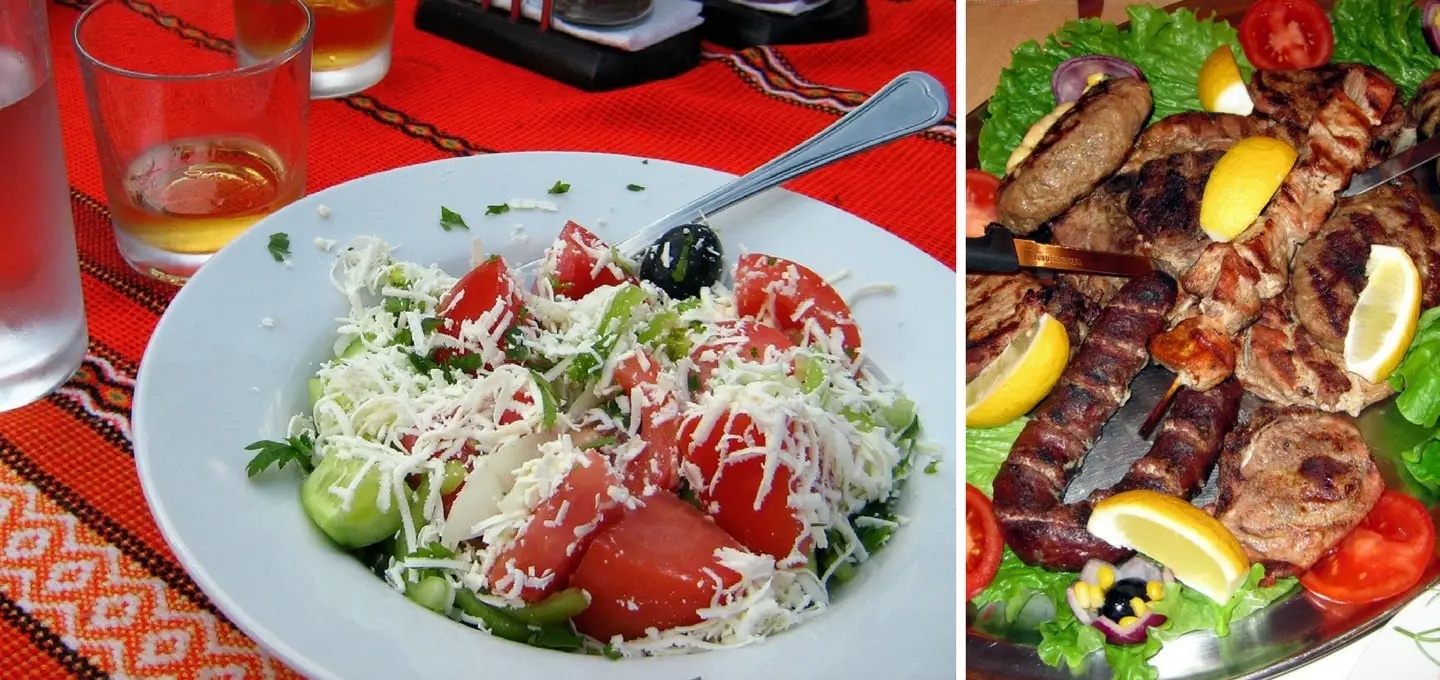
These 33 traditional Bulgarian dishes are quintessential for the Bulgarian cuisine.
I’ve divided them into categories, in the order in which they’re typically served. Note that Bulgarian food should be consumed with caution as it may lead to an addiction!
So, grab a napkin, and let’s dive in.
Bulgarian Starters and Soups to Tease Your Taste Buds
To tease your taste buds and get you in the right mood for a feast with Bulgarian food, start your meal with one or more of the following appetizers.
Salads from fresh or pickled vegetables are most commonly accompanied by a mouth-watering dressing of salt, oil, and vinegar. The dips go exceptionally well with freshly baked delicious bread. And the soups are served throughout the year.
Let me introduce you to my favorite Bulgarian starters!
1. Shopska Salad: The Most Famous Bulgarian Dish
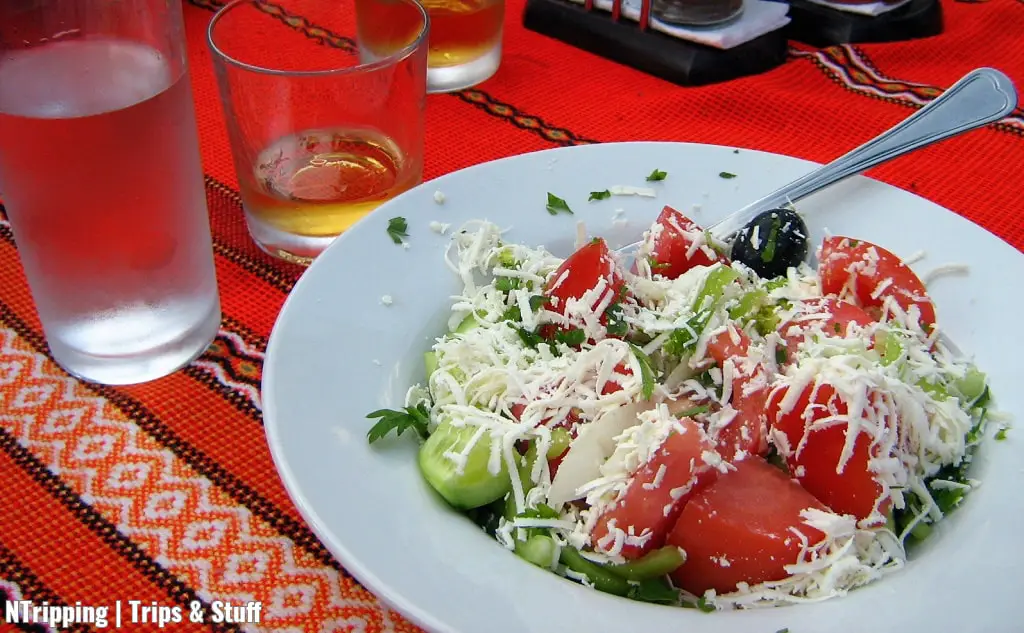
Fresh tomatoes and cucumbers join favors with white-brine cheese, peppers, onions, and parsley to give you a simple, yet heavenly delicious combination.
In neighboring countries, Shopska Salad is widely known as Bulgarian salad.
Maybe that’s due to the fact that everybody in Bulgaria loves the combination of fresh vegetables and herbs with Bulgarian cheese.
Or because the colors of the salad – white, green, and red – are the same as the colors of the Bulgarian flag.
Who knows? In any case, you shouldn’t miss tasting it.
2. Ovcharska Salad: Decadent Fusion of Vegetables and Proteins
We Bulgarians take the meaning of salad to a whole new level with Ovcharska Salad.
Translated as Shepherd’s Salad, this decadent fusion combines the same essential ingredients as Shopska Salad with the addition of ham, yellow cheese, mushrooms, and eggs for an even richer culinary experience.
The abundance of protein in Ovcharska Salad means it can actually serve as a whole meal. In fact, I’d often start and finish lunch with just Ovcharska Salad.
3. Green Salad: Spring’s Treasures on a Plate
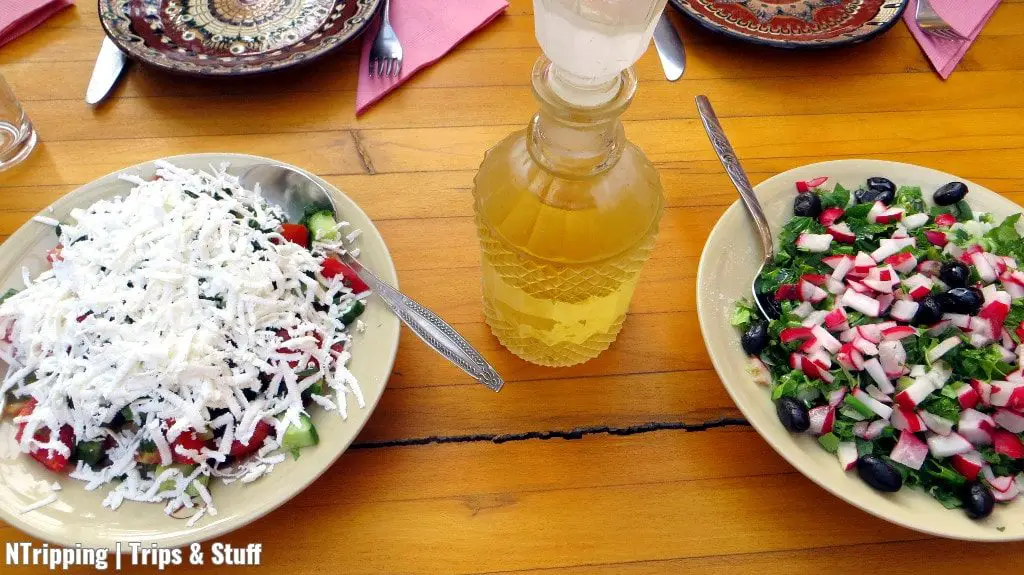
The Bulgarian Green Salad might sound simple, but it possesses a vibrant flavor.
The main components are lettuce, spring onions, and cucumbers, hence the name.
Other ingredients that are added to enhance the flavor and contrast the green hues are black olives, radishes, and hard-boiled eggs.
4. Vitaminoza Salad: Your Immune System’s Best Friend
Vitaminoza Salad, literally meaning “vitamin salad”, boasts shredded carrots, beets, turnips, and apples.
It’s garnished with garlic, olive oil, and lemon juice. It does combine a lot of vitamins, doesn’t it?
Order Vitaminoza Salad in all seasons to boost your immune system.
5. Grilled Peppers Salad: The Succulent Seduction
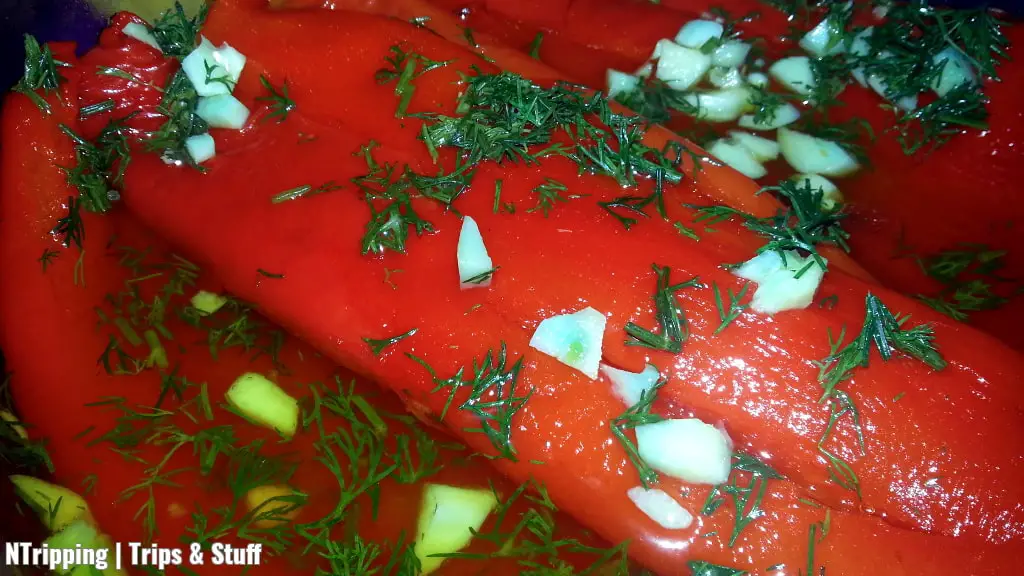
Grilled Peppers Salad is a decadent, succulent treat for your taste buds.
The peppers are served topped with dill and garlic. Drowned in copious amounts of vegetable oil, they’ll melt in your mouth.
✔️ Fun fact: I grew up to the smell of peppers roasting on an open flame at the end of summer and the beginning of autumn! Even nowadays, the Bulgarian countryside carries this amazing smell during harvest season.
6. Lyutenitsa: The Best Bulgarian Vegetable Dip
Lyutenitsa is the most popular Bulgarian relish.
It’s made from pureed grilled tomatoes, peppers, onions, garlic, salt, sugar, and oil.
Some recipes might contain carrots and eggplant. For an extra kick, chillis are added.
7. Snezhanka: The Fairytale-Like Yoghurt Dip
Bulgarian natural yogurt is a vital part of Bulgarian cuisine. I’ve shared why in the sections below.
Snezhanka is a yogurt-based thick dip featuring cucumbers, walnuts, garlic, and dill. It’s often decorated with black olives.
Snow White, as the name translates, is also known as dry tarator (see below). The reason for this is that the ingredients of both Bulgarian dishes are basically the same, but the consistency is different.
✔️ Warning: Never call Snezhanka tzatziki. Although similar, they’re not the same as the ingredients have completely different tastes.
8. Tarator: The Best Summer Refreshment
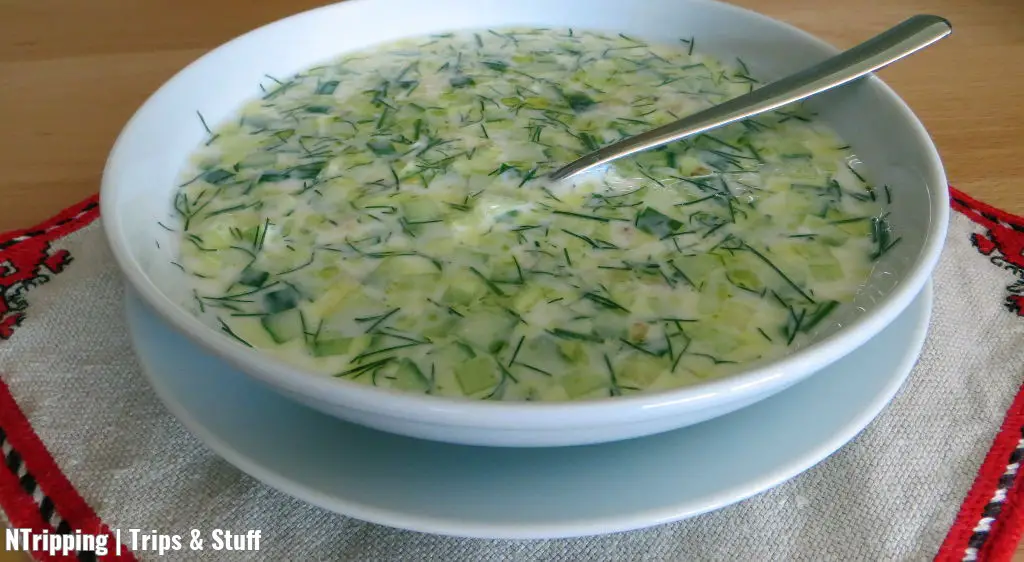
On a hot summer day, there’s nothing more refreshing than a bowl of Tarator.
The yogurt-based soup is a cold typical Bulgarian dish. It consists of watered yogurt garnished with cucumbers, walnuts, garlic, dill, and condiments.
This is the best Bulgarian food you can order on a hot summer day.
Many Bulgarian dishes use natural yogurt as garnish. However, tarator’s main ingredient is yogurt.
9. Teleshko Vareno: The Best Bulgarian Soup on a Cold Day
Teleshko Vareno is a thick veal soup.
It’s the most comforting Bulgarian meal on a cold winter day. My mom’s Teleshko Vareno has saved me from feeling under the radar on more than one occasion.
The tender cubes of veal meat flirt with large pieces of potatoes, carrots, and onions. The rich taste is quite unforgettable.
10. Bob Chorba or Bean Salad: Both Extremely Delicious
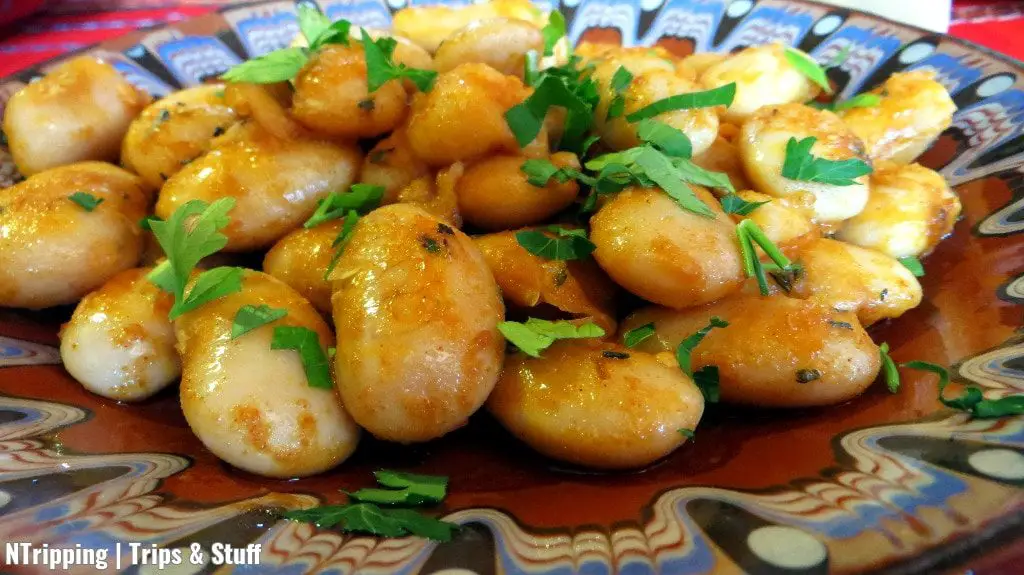
Bob Chorba is a traditional Bulgarian bean soup.
It can be prepared either vegetarian or with bacon. Both versions will warm your heart and palate, especially on cold days.
The more unusual version of this Bulgarian meal is a bean salad. It’s made of larger bean sorts, which are extremely satisfying to devour. The soft, large beans melt in your mouth like butter.
11. Kurban Chorba: The Soup Made for Celebrations
Kurban Chorba is influenced by Turkish cuisine.
This thick soup is usually prepared for a special occasion or celebration.
The meat used is lamb, sheep, or veal accompanied by offal. Usually, that’s the liver and the kidneys. Fresh, largely chopped vegetables give this hefty soup a delicious twist.
12. Supa Topcheta: The Most Surprising Way to Eat Meatballs
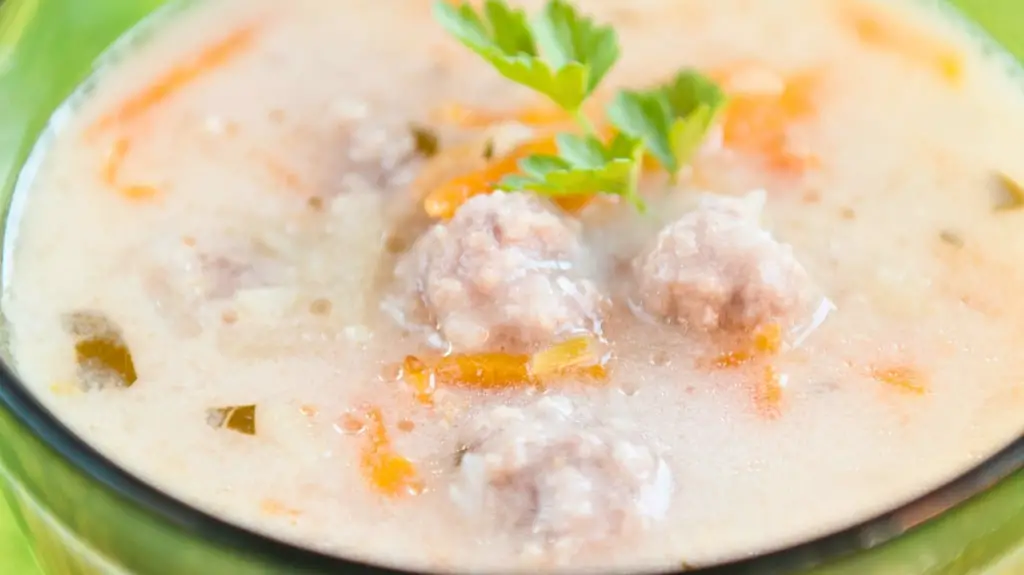
Supa Topcheta literally means “balls soup”.
The typical Bulgarian dish contains small pork meatballs. They’re cooked together with fresh vegetables, resulting in a delectable and visually satisfying soup like no other on Earth.
13. Tripe Soup: The Fiery Cure for Hangovers
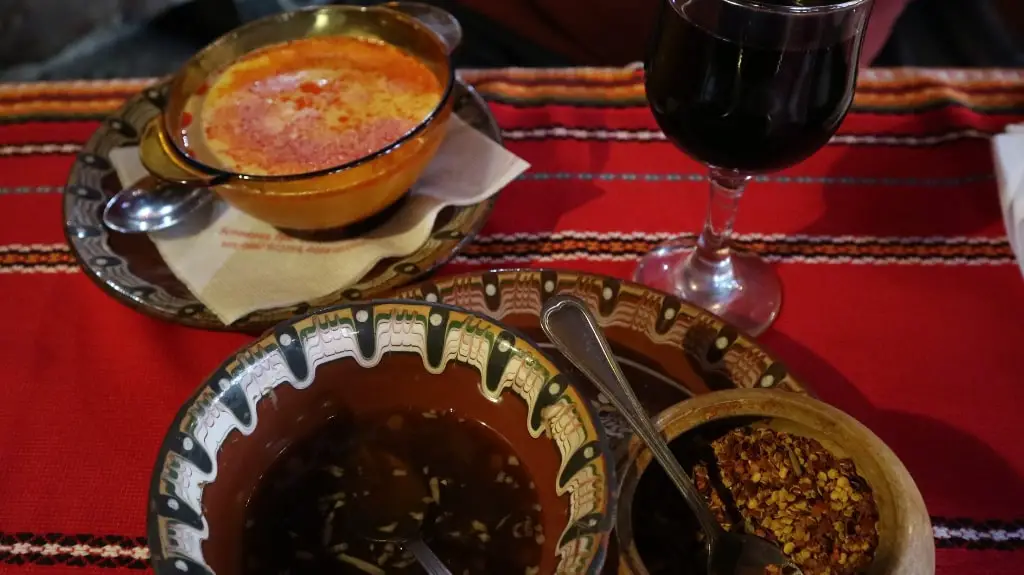
While most Bulgarian soups are enjoyed by both children and adults, Shembe Chorba (tripe soup) is definitely not on the children’s menu.
The main ingredient is tripe, the lining of the stomach of domesticated animals like pigs and cows.
The fiery taste comes from adding vinegar, infused with minced garlic, and dried hot chili peppers. Shembe Chorba lovers swear that it’s the perfect hangover cure. I can’t vouch for this as I’m in the team of those who don’t like the soup.
Traditional Bulgarian Main Dishes With and Without Meat
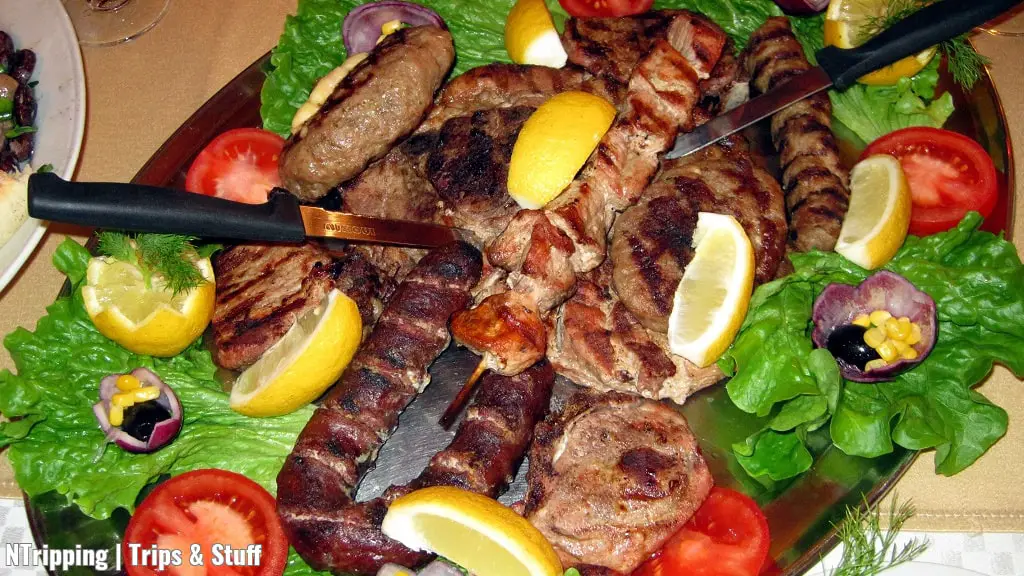
When it comes to meat, Bulgarians are flexible. Most often, Bulgarian dishes would be prepared with pork, but the same meal might also be cooked with chicken on request.
These are the most commonly consumed meats in Bulgaria:
- Pork
- Chicken
- Veal
- Lamb
- Goat
- Fish
- Rabbit
- Turkey
The most common ways of preparing meat are grilling, roasting, frying in the pan, and cooking as a stew. The latter is often served in a clay pot.
If you’re looking for vegetarian food, you’re in luck in Bulgaria. There is a huge variety of meatless dishes in Bulgarian cuisine.
In fact, many people fast before Easter and Christmas in Bulgaria. The culmination is on Christmas Eve when only non-meat Bulgarian dishes are served on the table.
14. Kebapche: The Most Iconic Grilled Bulgarian Food

Kebapche is minced pork, lamb, veal, or chicken meat with spices, formed as a long stick and grilled. Two kebapcheta between slices of bread is the most popular Bulgarian street food.
Kebapche is to Bulgarian cuisine what Bratwurst is to Germans or hot dogs to Americans.
You can find it in street food grill stalls, in small eateries, and even in high-end restaurants. But the best kebapche I’ve eaten was from my dad’s grill!
Consume your kebapcheta between slices of bread or with a side of chips, salad, and lyutenitsa.
15. Kyufte: The Bulgarian Twist on the Meatball
Kyufte is the Bulgarian version of the meatball.
It’s made from pork, lamb, or veal, with onion and spices to enhance the flavors. It could be grilled or cooked with a tomato-based sauce.
Along the classical kyufteta, several other variations exist. The most popular ones are tatarsko kyufte (Tatarian meatball), which is stuffed with cheese, and nervozno kyufte (“nervous” aka spicy meatball).
16. Karnache: The Tastiest Grilled Meat Spiral
Karnache is a thin sausage, rolled as a spiral from pork, veal, lamb, or mixed meat.
The added spices and the smoky flavor from the grill will make you lick your fingers.
Karnache is a type of nadenitsa, which is the typical Bulgarian sausage.
Just like kebapche, karnache is widely popular. You can find it anywhere and can devour it in a similar way.
17. Meshana Skara: Every Grilled Delicacy on One Plate
The signature Bulgarian dish Meshana Skara is a mixed grill plate.
It comes with several typical Bulgarian foods. Meshana Skara contains kyufteta (meatballs), kebapcheta, karnacheta or nadenitsi (sausages), steaks, and shishcheta (skewers).
Let me warn you before ordering one: don’t try to eat a whole Bulgarian mixed grilled plate alone!
The amount of food will usually be enough to feed a small army.
18. Tsatsa: Fish & Chips, Made in Bulgaria
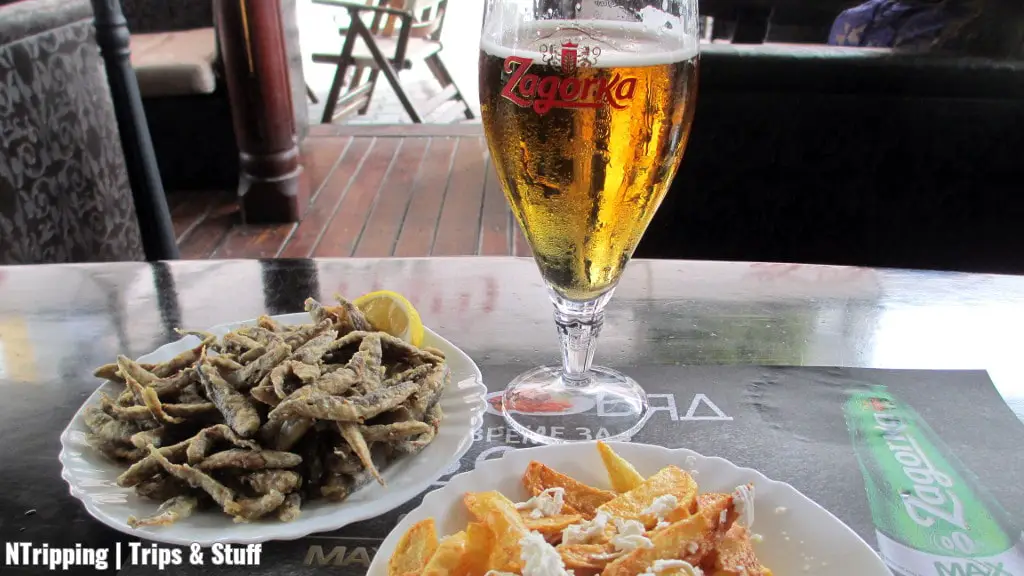
Tsatsa, deep-fried sprats with chips, was the most popular dish during our holidays on the Bulgarian seaside when I was growing up. It still tastes like summer and childhood memories to me. The tiny crispy bits are the Bulgarian version of the English fish & chips.
Other commonly consumed fish dishes in Bulgaria feature trout, mackerel, and carp.
For the best and freshest sea fish, you should visit the Bulgarian Black Sea coast.
19. Kashkaval Pane: Deep-Fried Yellow Cheese Delicacy
Kashkaval Pane is Bulgarian yellow cheese, breaded and fried in a pan.
It’s prepared in a similar way to the famous Viennese Schnitzel. Except for meat, you use a block of yellow cheese.
The result melts in your mouth and sends your taste buds into heaven.
20. Sirene po Shopski: White-Brine Cheese Enhanced with Vegies and Eggs
White-brine cheese, or sirene in Bulgarian, is one of the most important ingredients characterizing Bulgarian cuisine.
It’s used to garnish salads, potato fries, pizzas, and meals.
But in Sirene po Shopski, the cheese is the main character.
The combination of white-brine cheese, eggs, tomatoes, and butter combined together in a clay bowl is heavenly delicious.
21. Drobcheta po Selski: The Tastiest Chicken Liver Dish
Drobcheta or liver might not be everyone’s cup of tea. But you as an explorer should put your prejudice aside and order a portion of Drobcheta po Selski.
The succulent chicken livers are cooked in a pan richly dowsed with oil and wine. The most popular version of the dish is the so-called “po selski”, or “the peasant way”.
The liver pieces are accompanied with onions and peppers, and served with fresh parsley. This scrumptious Bulgarian dish is also one of the best complements to your glass of wine or pint of beer. In fact, I didn’t even like drobcheta po selski before I started drinking alcohol.
22. Cheverme: A Whole Roasted Animal on a Skewer
Cheverme is a whole animal, usually a piglet or a lamb, roasted on a huge skewer.
The meat extravaganza roasts on an open fire for four to seven hours. By the end, the meat starts to separate from the bone.
In Bulgaria, cheverme is usually served on special occasions. In restaurants, you should pre-order it because of the lengthy preparation. However, the waiting is worth it!
✔️ Tip: If you visit Sofia, Bulgaria, go to Restaurant Chevermeto. Yes, you’ve guessed it – cheverme is their staple dish and you can always order it there. Apart from the excellent food, the restaurant is famous for the performances of Bulgarian folk music and dances.
23. Kavarma: Tender Meat and Vibrant Vegetables in a Clay Pot
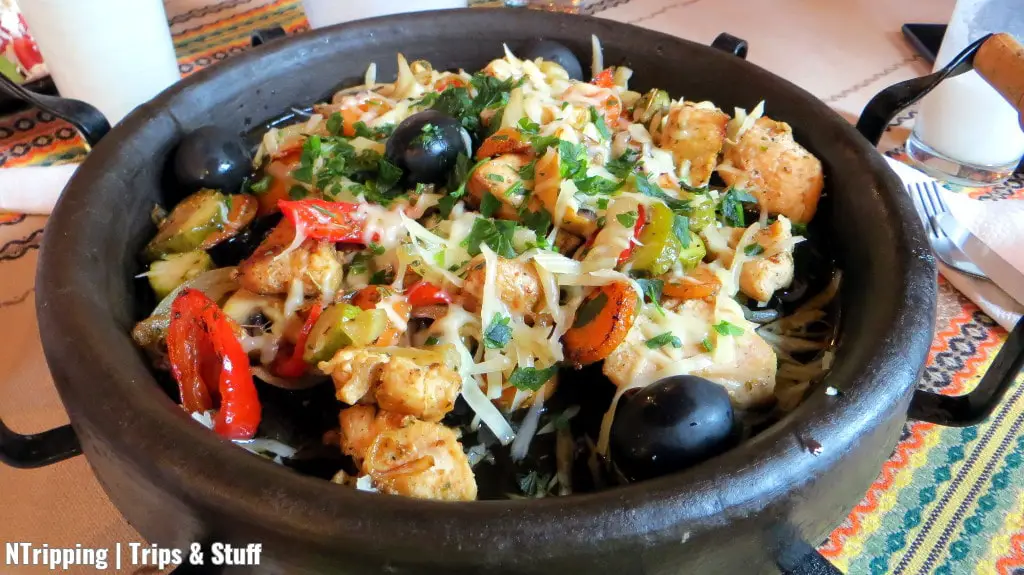
Kavarma is a scrumptious stew prepared in a clay pot.
It contains meat (pork or chicken), onions, peppers, and herbs.
Typically, kavarma is a slowly cooked Bulgarian dish. However, to speed things up, some restaurants will grill or sautee the ingredients, and only use the clay pot for serving the meal.
Both versions are very satisfying, and I’m even unsure which way I prefer to eat my kavarma. I’m pretty certain, though, that if I have to eat just one dish for the rest of my life, it would be kavarma.
24. Kapama: Layers of Meats Flirting with Sauerkraut
Kapama is a divine carnivore dish featuring several types of meat.
This heavenly Bulgarian food is prepared in a sealed clay pot.
Several different types of meat (pork, chicken, lamb, rabbit, veal, and sausage), sauerkraut, dried plums, and spices are layered in the pot, covered with red wine, and slowly cooked for several hours.
The meats are layered in a pot with sauerkraut in between. As if that’s not enough, the Bulgarian dish is topped with a sausage.
Before it starts cooking for several hours, red wine joins the pot.
It sounds hefty, but if prepared right the meat melts in your mouth and the sauerkraut adds a heavenly fresh flavor.
25. Sarmi: Stuffed Leaves for Vegetarians and Meat Lovers
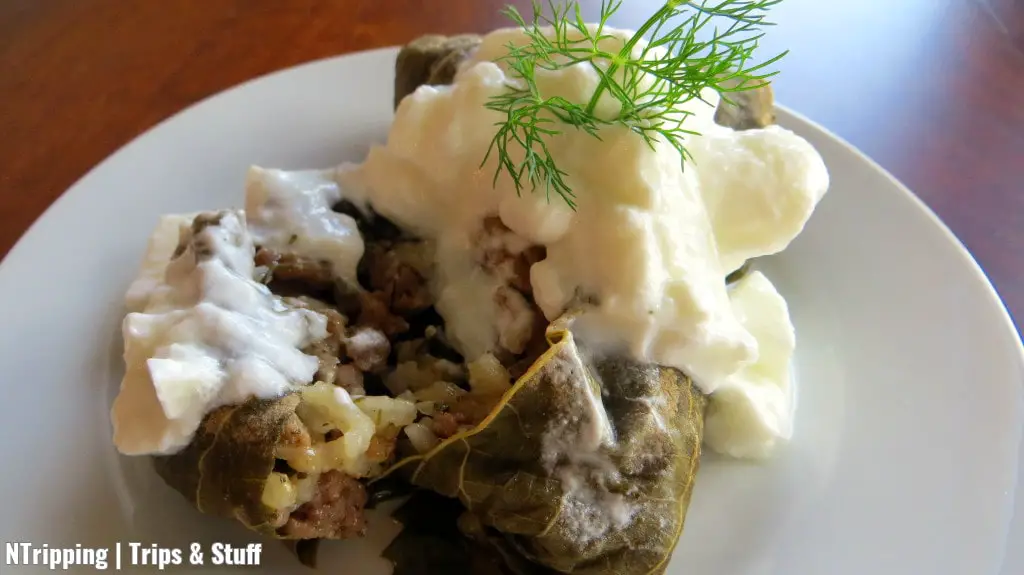
Sarmi uses vine or cabbage leaves to wrap around a mixture of minced meat, rice, and herbs.
This Bulgarian dish can be either vegetarian or carnivore.
The vegetarian option of the meal is prepared without the minced meat. Instead, chopped vegetables and raisins are added.
Sarmi are often served with natural yogurt on top to further enhance the flavors.
You should try all variations of sarmi to find out which version of this Bulgarian food you like the most.
26. Stuffed Peppers: Surprisingly Tender and Satisfying
The Bulgarian Stuffed Peppers are filled with a mixture of minced pork, rice, and spices.
They are prepared and served with or without a tomato-based sauce.
Alternatively, zucchini or eggplants might also be stuffed.
And for a vegetarian version, you can skip the meat and stuff them with rice, herbs, and raisins only. Another equally delicious option is with a filling of white-brine cheese and whisked eggs.
27. Drob Sarma: Heavenly Combination of Offal and Rice
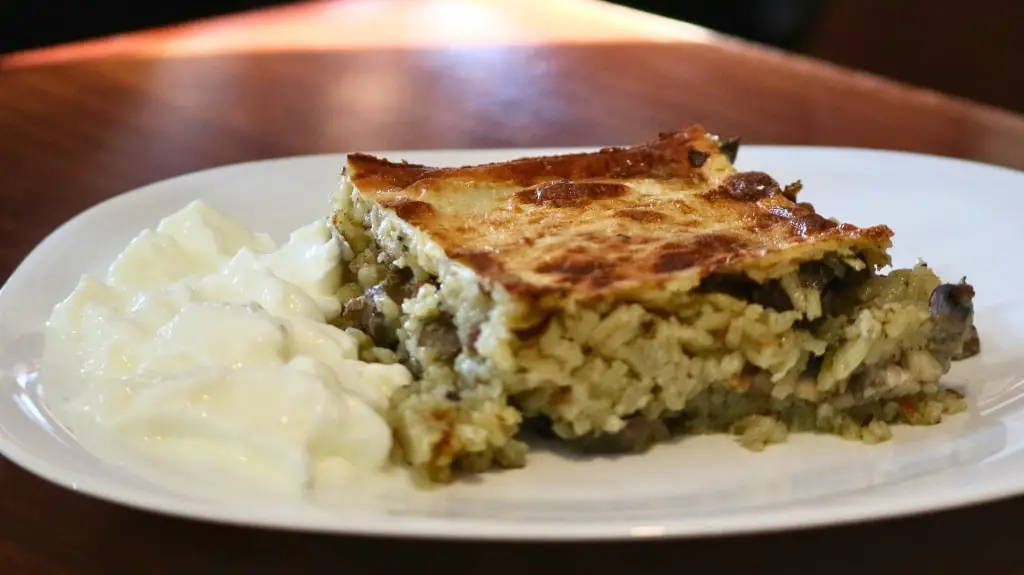
Drob Sarma is a rice-based dish, which you can order as a side dish to meats or on its own.
The rice is mixed with chopped offal, meat, mushrooms, and spices.
If served as a standalone meal, it is prepared in a caul to keep its form and add more taste.
Alternatively, a mixture of eggs and yogurt can be used as a topping.
28. Eggs Panagyurian Style: The Best Way to Eat Your Eggs
Eggs Panagyurian Style are poached eggs Bulgarian dish. The eggs are broken over boiling water and cooked for a few minutes until they’re done on the outside and runny inside.
The eggs are then served over thick Bulgarian yogurt, and richly topped with melted butter and paprika.
In some eateries, the eggs might come with mushrooms or cheese on top for extra flavor.
29. Kachamak: The Tastiest Corn Porridge Meal
Kachamak is a simple yet delicious maize porridge.
It’s served doused in melted butter and paprika, and topped with white-brine cheese.
For a more decadent taste, some versions of kachamak incorporate crunchy homemade pork cracklings.
The Best Bulgarian Pastries, Desserts, and Snacks
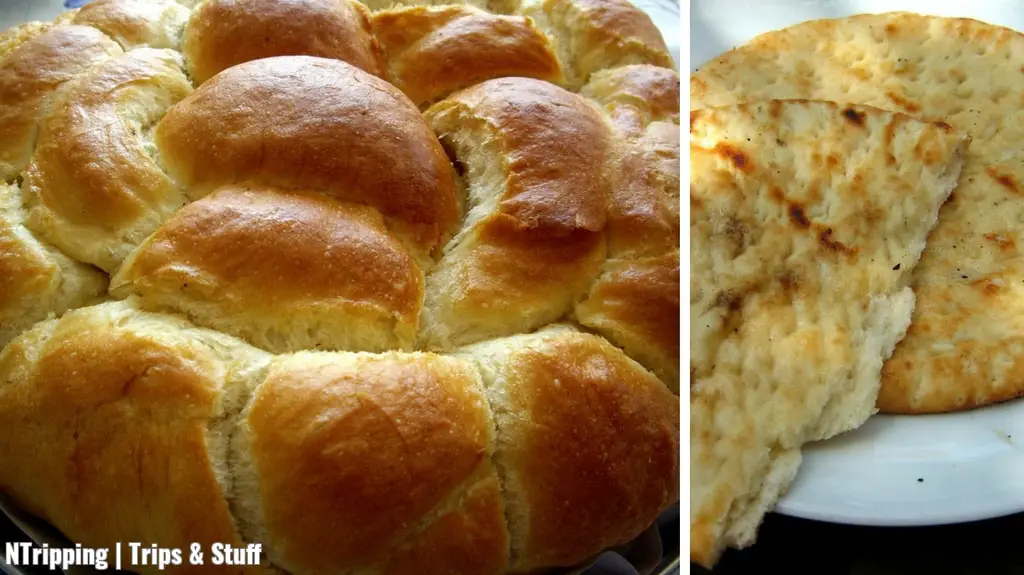
You can eat Bulgarian pastries for breakfast or at the end of a meal.
Basically, if you’ve been invited to dinner and didn’t finish your dessert, your host will pack it so you can enjoy it for breakfast the next day.
You’ll find it interesting that bread accompanies every Bulgarian meal. It’s unthinkable to start eating without some on the table. Traditionally, bread is made of white wheat flour.
The home-made types of bread you should definitely try are:
- Parlenka. A small thin pita bread, baked on a stone plate.
- Pitka. This traditional bread varies in size and complexity. It’s usually prepared for a holiday celebration. The decoration of the bread depends on the occasion.
Below, you’ll find the most typical Bulgarian desserts, snacks, and breakfasts:
30. Banitsa: The Best Pastry You’ve Never Tried

Banitsa is like no other pastry in the world. It’s so simple yet so multi-layered (pun intended).
The fact that you can stuff the layered dough with a wide variety of fillings – both sweet and savory – is reason enough for the above statement.
Moreover, you can eat banitsa not only for every meal of the day but also as a dessert or as a snack in between meals.
The most popular Banitsa filling consists of whisked eggs, yogurt, and white-brine cheese. Alternatively, banitsa can feature leek, spinach, or cabbage.
The sweet version includes pumpkin, milk, and walnuts.
You can buy street food banitsa in every corner of Bulgaria.
However, the best banitsa is the homemade banitsa from a Bulgarian grandma. Just be careful, because our grandmas are notoriously famous for overstuffing their grandchildren with scrumptious Bulgarian food!
31. Strained Yoghurt: Healthier and Tastier Than Ice-cream
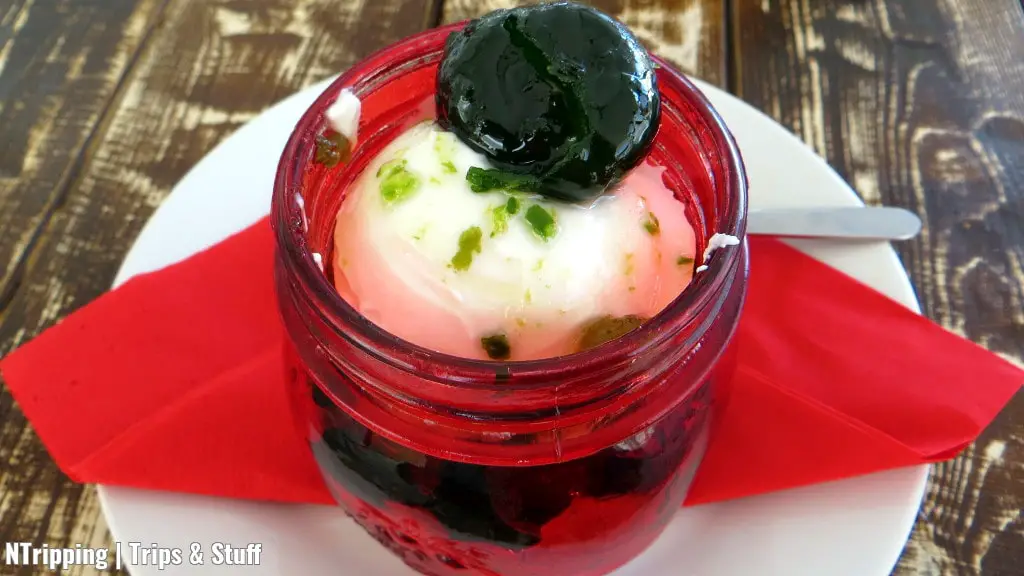
Since yogurt is such an important Bulgarian product, you can start and finish your meal with dishes mainly comprised of this scrumptious dairy product.
To make Strained Yoghurt, you simply put natural Bulgarian yogurt in a cloth overnight. The water strains from the yogurt, leaving you with a thick crème that’s more delicious and healthier than any ice cream.
You can top your strained yogurt with honey and walnuts or add a spoonful of jam. My favorite topping is green figs jam. The figs’ sweetness complements the slightly sour taste of the Bulgarian yogurt for the ultimate gastronomic climax.
32. Kozunak: The Best Bulgarian Sweet Easter Bread

Kozunak is a sweet bread with walnuts and raisins, typically baked for Easter.
The delicious yeast bread resembles a coffee cake. The inside is yellow in color and succulent in taste. The outside is dark brown and crispy.
The dough is braided several times, giving kozunak its interesting shape.
33. Cured Meat and Cheese Platter: The Best Way to Finish Your Bulgarian Meal
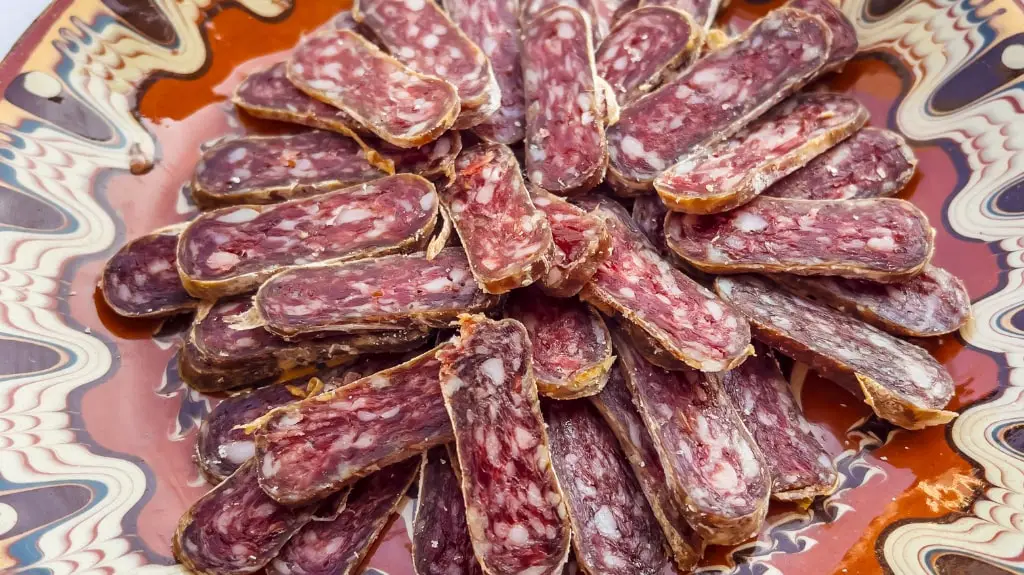
At the end of the meal, you can order a platter of cured meat and cheese for your digestive.
The Bulgarian cheese is white-brine cheese, sirene, and yellow cheese, kashkaval.
The most typical Bulgarian cured meats are lukanka and pastirma.
Lukanka is a semi-dry salami from pork, veal, or game meat enhanced with spices and herbs. It has a distinguishable flattened shape.
Pastirma is an air-dried cured beef delicacy, rolled in dried savory.
Bulgarian Drinks to Accompany Your Tasty Bulgarian Meals

No tasty Bulgarian meal will be the same without the support of a delicious beverage. So, without further ado, let’s dive into the wonderful world of Bulgarian drinks.
Bulgarian Wines: The Nectar of the Gods
Bulgarian wine production has a long history, dating back to the Thracian civilization. Long before Christianity, Thracians made and drank the Godly nectar on the Bulgarian lands.
One of the most interesting facts about Bulgaria is that in the 1980s, the country was the world’s 2nd largest wine producer.
Unfortunately, bad politics after the end of the communist era led to lost markets and lowered production capacities. Thankfully, in recent years, Bulgarian wines have regained their popularity among wine lovers.
These are the most popular local wine sorts, which will complement your tasty Bulgarian food:
- Mavrud. A red grape, indigenous to Bulgarian lands, capable of producing tannic, spicy wine with potential for aging. The wine is thick and strong, and goes well with your red-meat Bulgarian dishes.
- Gamza. A red vine, used for producing both dry red and sweet dessert wines. It is characterized by full taste, deep aroma, and dark color.
- Rubin. A hybrid red vine, selected in the 1940s by combining Syrah and Nebbiolo grapes. It produces dry, semi-dry, and sweet wines. They taste of berries and have the potential for aging.
- Shiroka Melniska loza (Broadleaf Melnik Vine). A red wine that has an affinity for oak and can produce tobacco notes. Wine aficionados such as Winston Churchill loved this wine.
- Pamid. This was once the most widely spread vine in Bulgaria. Pamid wines are light red table wines with low acidity. They’re inappropriate for aging. Hence, you should consume them young, right after fermentation and clarification.
- Dimiat. A white wine grape, indigenous to Bulgaria. It is one of the most widely planted white grape varieties. Dimiat wines are noted for their perfume aromas.
- Plovdiv Malaga. A hybrid vine, produced by crossing Cherven Misket (red dessert wine) and Black Muscat (white dry wine). The obtained wine is a high-quality red dessert wine with an intense color.
Rakia: The Fiery Drink Which Cures Everything

In addition to the palatable Bulgarian wines, you should also try Rakia.
The brandy-like liquor is the most popular traditional high-percentage alcoholic beverage. You can find a drink with the same or similar name in almost all countries of the Balkans. The taste and the manufacturing process are quite similar.
Rakia is produced by distilling fermented fruits or wines. The initial color is clear. By aging in barrels or adding herbs, the color changes to yellow or brown.
The alcohol percentage varies but most commonly is around 40% vol. Home-made rakias might reach 65% vol. Some brands taste very smooth, so drink responsibly.
The most widely used fruits for the distillation of rakia in Bulgaria are grapes and plums. Other fruits used to make rakia are apricot, peach, pear, apple, quince, fig, and cherry. There’s even pomegranate rakia!
In summer, rakia is usually served cold, while in winter you’ll drink it either at room temperature or mulled with honey and spices.
Bulgarian Beer You Should Try
If rakia is not your cup of tea, you can always order a beer.
Local Bulgarian beer is inexpensive. Most popular are unsurprisingly lager beers. Beer aficionados can also order dark beers, IPAs, and wheat beer.
The most popular local brands include:
- Zagorka
- Stolichno
- Kamenitsa
- Shumensko
- Pirinsko
- Ariana
- Burgasko
If you want something exquisite, try Bulgarian craft beers. Their flavor combinations will surprise your taste buds pleasantly.
These are the brands I recommend:
- Glarus
- Fifth Ocean
- Divo Pivo
- Ailyak
- Byal Schturk
Surprising Bulgarian Non-alcoholic Drinks
In addition to alcoholic drinks, there are several non-alcoholic beverages produced and enjoyed in Bulgaria.
Some of the tastes require getting used to.
- Boza. A thick drink made of fermented millet flour. It shocks with its brown color, unpleasant smell, and weird taste for anyone who hasn’t grown up drinking it. If left for several days, it starts fermenting and tasting sour.
- Ayran or Matenitsa. A yogurt drink with a pinch of salt. It is the best refreshment you can ask for in the hot summer months.
- Mineral water. If you’re counting calories or trying to avoid unusual tastes, stick to water. Bulgaria is extremely rich in mineral waters. You can buy a bottle of healthy and delicious Bulgarian mineral water for a few cents practically everywhere.
- Coffee. By default, when you order coffee in Bulgaria, you get espresso. In some regions, drinking Turkish mocca is still the preferred way to consume caffeine.
The Secret Ingredients That Make Bulgarian Food Taste Amazing
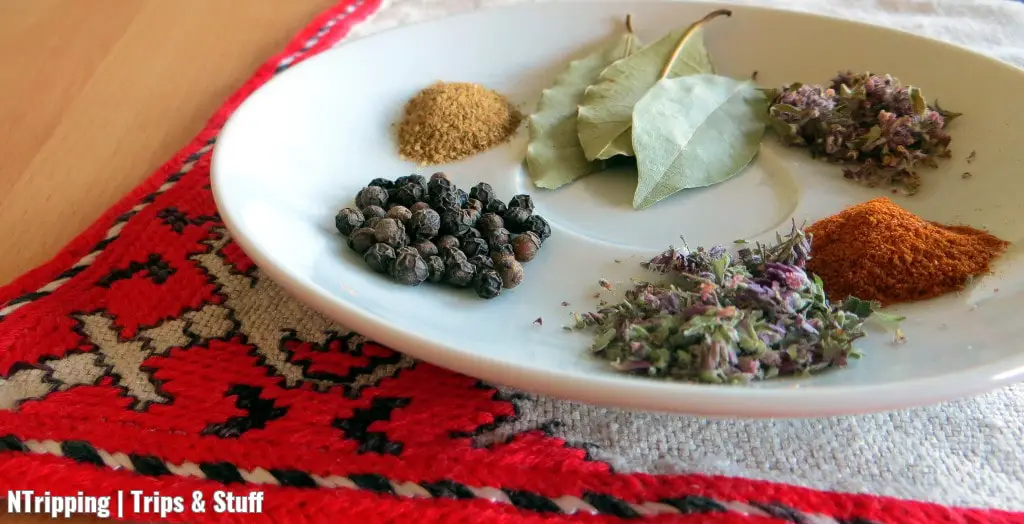
As in any national cuisine, the ingredients used to prepare Bulgarian food play an important role.
When fresh local vegetables, various meats, fragrant spices, and dairy products are combined in a dish, the result is much more scrumptious than the sum of its parts.
Below, you’ll find what secret weapons Bulgarians use in their kitchen to produce the unique taste of traditional Bulgarian dishes.
Spices Used to Prepare Traditional Bulgarian Dishes
Spices can make or break a meal.
If you want to discover the secret to the incredibly delicious taste of Bulgarian food, this section is for you.
These are the spices and herbs, which give traditional Bulgarian dishes their unique taste:
- Savory. The most widely used spice in Bulgarian cuisine is savory. You can add it to almost every cooked meal or soup to enhance its flavor.
- Thyme. The fragrant spice is best used in traditional Bulgarian dishes including meat.
- Rosemary. This aromatic herb accompanies dishes with potatoes or fish.
- Oregano. It seasons both traditional meat and vegetarian Bulgarian dishes.
- Basil. You can put it fresh in salads or dried in soups and cooked meals.
- Spearmint. It is a must in any dish, containing beans.
- Parsley. Commonly added fresh in all kinds of salads.
Typical Bulgarian Products with Unique Taste
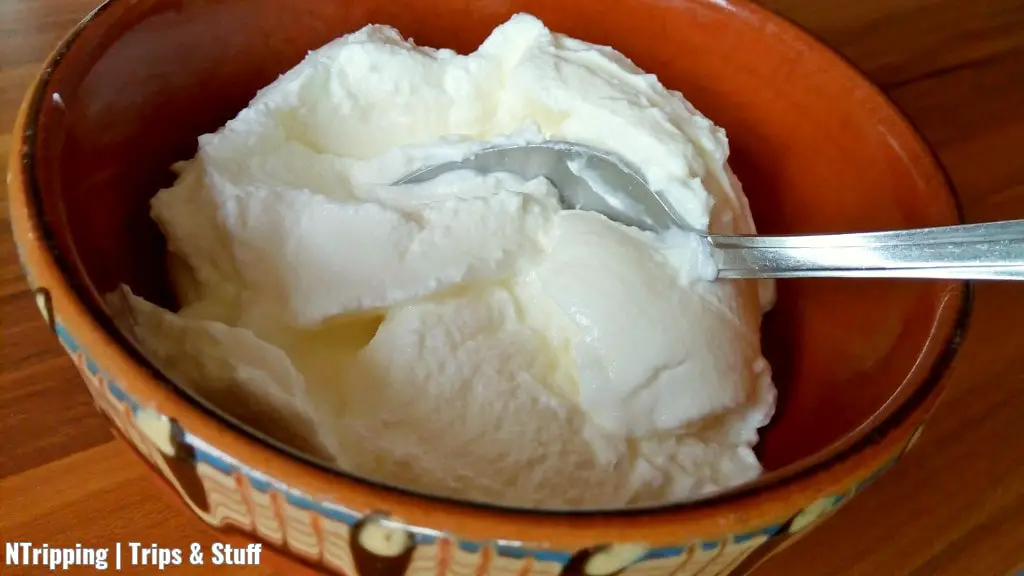
Bulgaria is famous for its dairy products.
Several of them are widely used in Bulgarian cuisine. Cow, sheep, goat, and water buffalo milk is used to prepare them.
Here are the most crucial products:
- White-brine cheese. Together with whisked eggs, it’s used in the filling of pastries, such as banitsa and tutmanik. Alternatively, it can be part of a platter with cold meze, alongside lukanka and pastirma. But that’s not all! White-brine cheese can also be stuffing for peppers or meatballs. The unique salty taste of the cheese combines phenomenally with almost any fresh vegetable. The tastiest Bulgarian salads are sprinkled with shredded white cheese.
- Natural yogurt. Another signature dairy product of the Bulgarian cuisine is yogurt. Bulgarian yogurt has a different taste from any other yogurt you’ve ever tried. Thanks to the Lactobacillus bulgaricus bacteria, which only grows on Bulgarian lands, the heavenly taste of Bulgarian yogurt participates in a wide variety of dishes. You simply can’t eat sarmi or green beans stew without a spoon of yogurt on top. The topping for mousaka is also prepared with yogurt. There’s even a yogurt soup, tarator! The most refreshing drink, ayran, is made of yogurt, too.
- Fresh vegetables. In addition to dairy products, fresh, tasty Bulgarian vegetables are used to make the most scrumptious salads and cooked meals you’ll ever try. Also, dips like lyutenitsa wouldn’t be as heavenly delicious if it weren’t for the fresh veggies used.
Tips and Warnings About Bulgarian Food
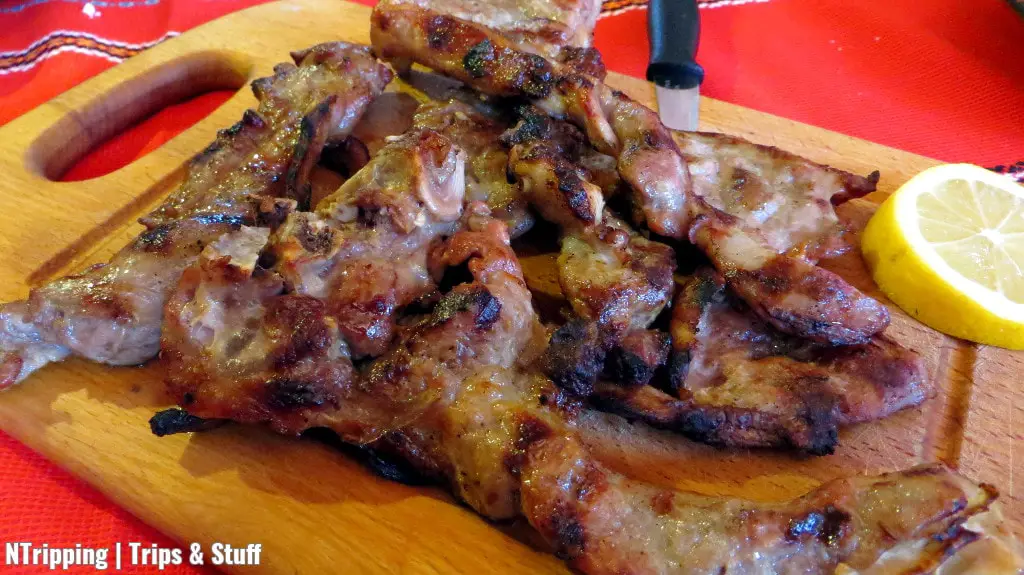
- Bulgarian Food is closely related to Bulgarian history. Bulgarian cuisine was influenced by Turkish and Greek cuisines. The different taste of Bulgarian people has also added a unique twist to almost every meal served on Bulgarian lands.
- In some regions of the country, you’ll find local specialties not prepared anywhere else. This depends on the ethnicities living in the region. Some of the traditional local dishes are so scrumptious, that it’s worth the effort of venturing there just to try them.
- Eating bread has its own rules. Tearing a small piece of bread and putting it in your mouth with your fingers is fully okay in Bulgaria. However, dipping a piece of bread in a dip or soaking it in the gravy should be done with a fork.
- Sharing your food is normal in Bulgaria. When ordering at a restaurant, most people will order different dishes. They will often offer you to try their traditional dish or ask directly to taste yours. If someone notices you’re not going to finish your food, they’ll often ask if they could finish it for you, so it doesn’t go to waste.
- There’s no particular order in which ordered dishes will arrive. The dish, which is ready first, will be served first. There’s no waiting for everyone’s food to be ready and served at the same time. This means that people will start eating the moment their food arrives, hence they’ll offer to share if yours hasn’t been served yet.
- It’s impolite to leave food on your plate. At a Bulgarian celebration, your plate will be served full. In fact, it’ll be overflowing with a huge mountain of freshly prepared Bulgarian food waiting for you to devour. And as soon as you start seeing the bottom of the plate, more food will be added to the table.
- The typical aperitif in Bulgaria is rakia. The strong alcoholic drink is the first one on the table. Don’t even think of drinking it like a shot! With your empty stomach, you’ll collapse before they start serving Bulgarian food. Instead, sip your rakia slowly and wait for the starters to arrive.
FAQs About Bulgarian Food

What is the most popular Bulgarian dish?
The dish that’s a synonym of Bulgarian cuisine is shopska salad. The tasty traditional dish, made with fresh vegetables, is even called Bulgarian salad in neighboring countries. It consists of chopped ripe tomatoes, juicy cucumbers, onions, peppers, and parsley. Topped with grated white-brine cheese, it’s a quintessential Bulgarian food. Its colors even resemble the Bulgarian flag – white, green, and red.
What is a traditional Bulgarian food?
The most traditional Bulgarian products that are always present on the table are yogurt and white-brine cheese. They’re the main ingredients in many Bulgarian dishes as well. The most popular pastry is banitsa and the most popular salad – shopska salad. The most famous grilled dish is kebapche and the most ordered soup – tripe soup.
What is a traditional Bulgarian breakfast?
Traditional Bulgarian breakfasts include banitsa, popara, and kifla. Banitsa is a filo dough pastry, filled with white-brine cheese and whisked eggs. Popara is made of bread, white-brine cheese, and honey, soaked in fresh milk. Kifla is a fluffy pastry filled with rosehip jam or chocolate.
Now You’re an Expert on Bulgarian Food
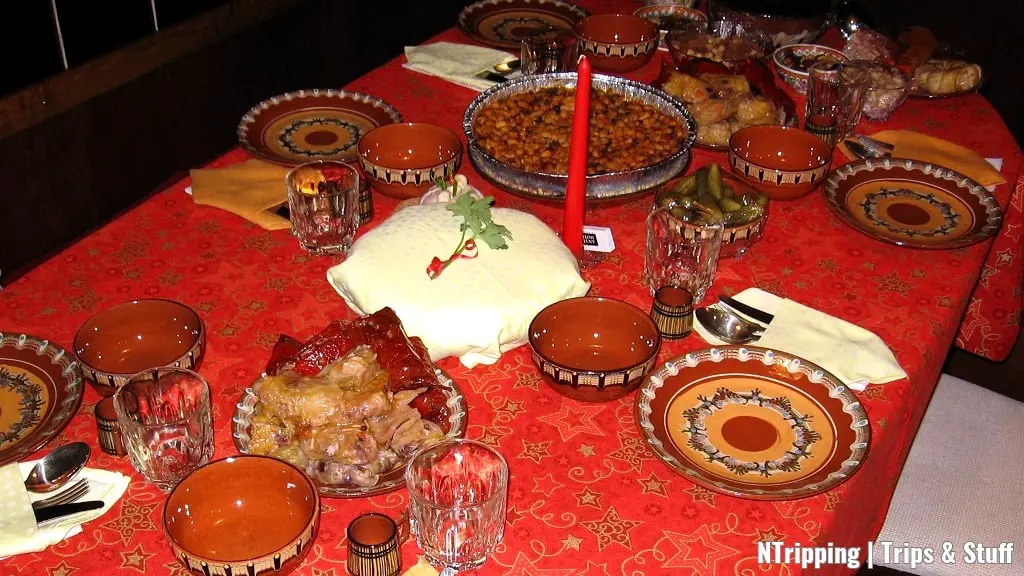
Now you know what traditional Bulgarian dishes you should try on your visit to Bulgaria.
From the tastiest pastries to the freshest salads, and from the heartiest meats to the healthiest starters, you’re an expert on Bulgarian food.
I hope you’ll agree that Bulgarian food is one of the best reasons to visit Bulgaria.
Before you go, do me a quick favor:
Share this guide with everyone who might be interested in trying something new, astonishing, and different.
Let’s spread the word about the surprising Bulgarian cuisine, the most delicious food you’ve never tried!
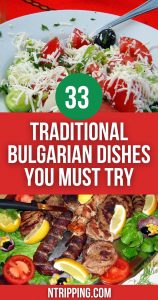
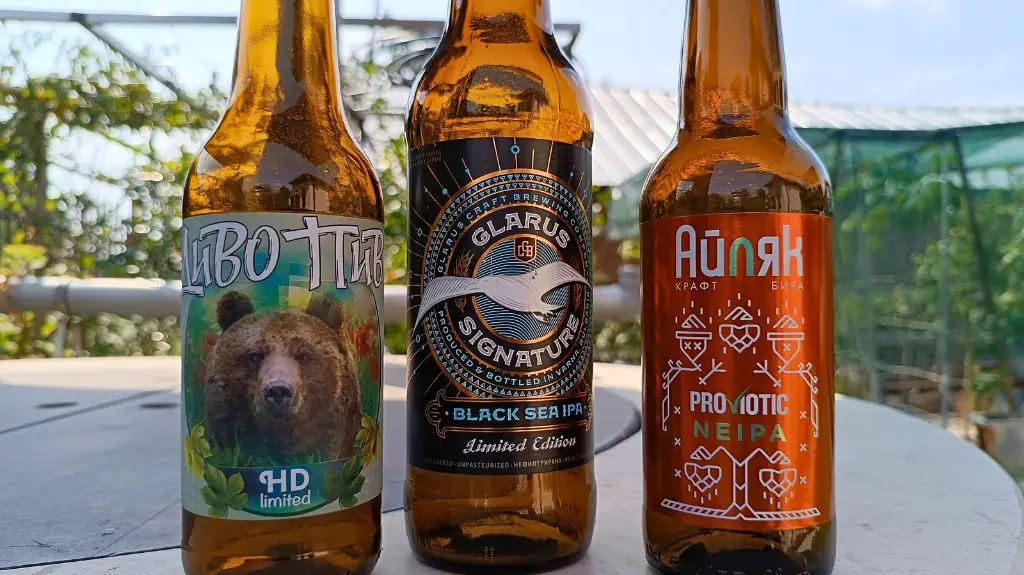






Naddya, this article is pure awesomeness!
Congratulations. I will definitely share it often. I just did with a couple of friends.
You are right – there is no way to be comprehensive about a certain cuisine, but this is close to perfect :)
Svet, your words mean a lot to me! It sure pays off for all the effort, when you read a comment like this shortly after hitting publish ;)
And thanks for the shares, highly appreciated!
Cheers,
N.
Yes, I know that feeling, so I am expressing my support so openly! :))
Cheers and keep it up,
Svet
Thanks, Svet, I will :)
Naddya, Thank you for the detailed article!
Now I can explain Bulgarian cuisine to foreigners with just one link!
Keep up the good work!
Bistra
Hey Bistra, glad you liked it and feel free to share the guide :)
Cheers, N.
Thanks for the detailed info
Will be in Bulgaria next week, looking forward to it. (and the food)
You’re welcome! Enjoy your stay in Bulgaria and I hope you share your experience afterwards :)
Cheers, N.
As an expat now living in BG, only one minor “quibble” with your excellent overview…On one of my first visits to Bulgaria, I was the honored guest at dinner one night. It transpired exactly as you said. Food for dozens, though there were just eight of us around the table. The food was homemade, delicious and plentiful. And every time I emptied my plate the hostess insisted on filling it again. I finally had to leave food on the plate–I had no choice. It was the only way I could get the hostess to stop serving me food.
I’ve lived here a couple years now and find the food generally excellent and a tremendous value for travelers from North America or Western Europe. It’s really hard to go wrong here. And to have the opportunity to enjoy home cooking is about as good as it gets.
Thanks again for this great overview!
Hey Chris, thanks for sharing this story and I’m glad you liked the post :)
Cheers, N.
Excellent article. I agree with almost everything except for this part: “Drinking tab water in the capital city of Sofia is not advised”. The tab water in Sofia is excellent and completely safe for drinking. Not only that but most of the city is supplied with water directly from the Rila water pipe which makes the water cold, clean and delicious.
I am here with Boris. The water in Sofia is delicious (well, in most parts of the city). But, guys, it is tap, not tab :)))
Svet, thanks for the correction, I’ll fix this :)
Thanks for commenting, Boris!
I think the problem is not the source, but the maintenance of the pipelines in some parts of Sofia, which make the tap water taste unpleasant. I personally don’t drink it and therefore can’t recommend doing so. Maybe it’s just my neighbourhood but I’m sticking to mineral water :)
Cheers, N.
Oh, yes, we should all blame it on the pipelines. I have a friend in a neighbourhood in the West where the water is simply undrinkable. :)
I agree.
However if someone is visiting Lozenets, drink it without hesitations :D
“the eggs are broken over boiling water” = poached eggs ;)
Thanks for the clarification, foe!
Have a great weekend :)
Hey Naddya,
Great stuff here! Very, very informative guide. Hope to visit Bulgaria one day and I’ll refer to this then!
Thank you, Maheima! I’m glad you liked the guide and I sincerely hope you do visit Bulgaria one day :)
Happy travels!
Cheers,
N.
Excellent guide! As a chef and culinary travel professional, I love reading about local cuisines to learn more about the dishes, spices, ingredients and methods of preparation that make them special.
Thanks, Linda, glad you liked the guide :) Bulgarian food is totally worth a try and even a visit to try the dishes at the source!
Happy travels :)
Hi i would like to answer your question , about why sometimes we drink beer after all that food and drinking several glasses of rakia. First of all its much easier to switch from hard alcohol to soft one. Its harder to get wasted drinking rakia and having a beer or two after, now if you start with beer and then switch to rakia you are game over my friend.You may act sober, but you are not. When you drink Beer after eating and drinking rakia it is used mostly as a relaxing your stomach from all that eating. Most friends i talked with about this they say it feels like a cold drink in a hot summer day, just refreshing. Also it helps a lot at least for me with digestion. Also let you know that no matter what is your poison if you over use it, you will get wasted even if you drink beer or wine.So drink in moderation and know your limit. Perfect guide by the way liked it very much.
Hey Miroslav,
thanks for the comment. I don’t agree with everything you said about alcohol, but one thing you mention is for sure indisputable – excessive drinks are what’s dangerous for you :)
Glad you liked the post!
Cheers,
N.
Oh my…. I really need to come to Bulgaria and eat my way through this interesting country. Let’s say you have more than wet my appetite! I must eat my way through the ten must do’s.
MJ, I’m sure you’ll love eating in Bulgaria :) You have one more reason to come visit me now!
Cheers :)
I can smell the aroma of those grilled food from your photographs. I would want to try them all hahah.
Wow, this is a comprehensive and mouth-watering guide to Bulgarian cuisine! From the refreshing Shopska Salad to the hearty Cheverme, you’ve beautifully showcased the diversity and richness of Bulgarian dishes. The detailed descriptions make it clear why Bulgarian food is so beloved and even addictive!
The way you’ve broken down each category—from starters and soups to main dishes and desserts—really highlights the variety and depth of flavors in Bulgarian cooking. I can almost smell the grilled peppers and taste the creamy Snezhanka. And the inclusion of Bulgarian wines and rakia adds the perfect touch to round out the meal.
Your enthusiasm for Bulgarian food is infectious, and it’s clear that each dish is not just a meal but a part of the cultural experience. I’m definitely tempted to try every dish on this list. Thanks for this delicious virtual tour!
Hey Kiran,
thank you for your kind words! You’re always welcome to visit Bulgaria and try all the fantastic dishes Bulgarian cuisine has to offer :)
Cheers and happy travels,
Naddya
Hey Naddya,
Thank you so much for the warm invite! I’d love to visit Bulgaria and sample the incredible Bulgarian cuisine—sounds like an amazing experience. I’ll definitely keep that in mind for future travels! By the way, I will be travelling to Tokyo early next year.
Wishing you all the best,
Kiran